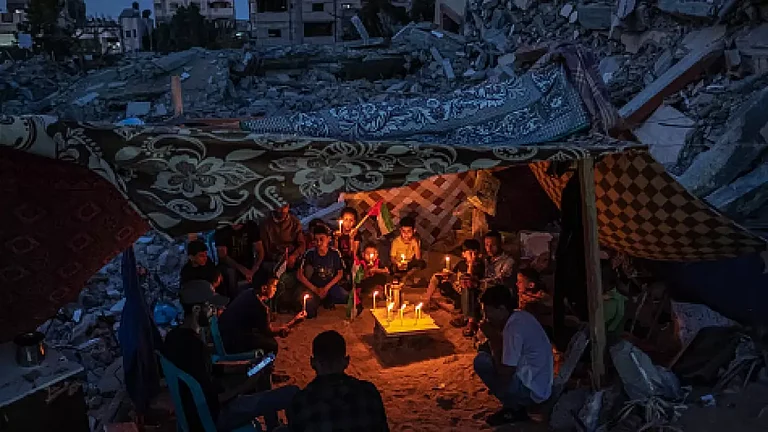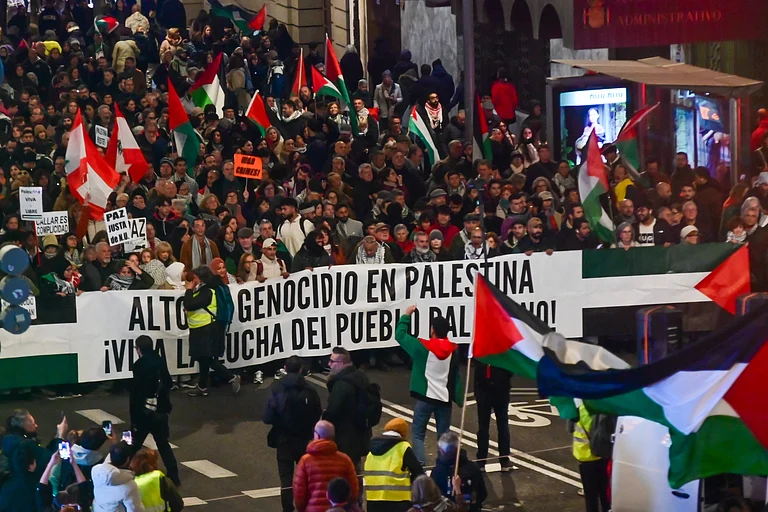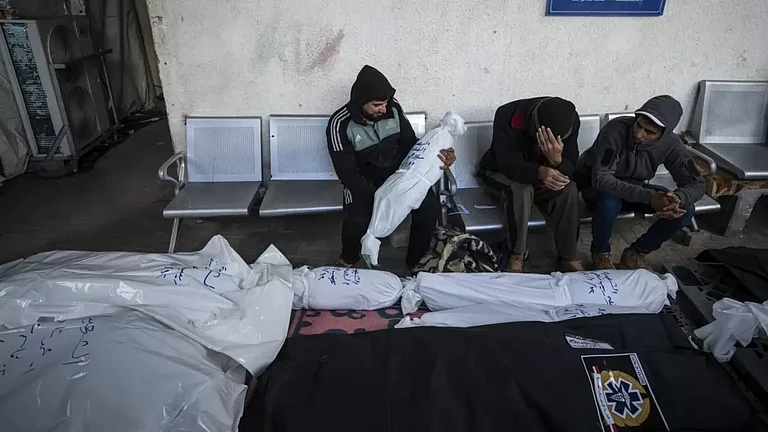Over 60 journalists have already been killed by Israel, with several experts terming their deaths a result of ‘journocide’.
Visuals are beyond any metaphor that language can offer.
Visuals of a father, in a desperate frenzy, gathering the bloody remnants of his children in grocery bags or another, collecting shattered limbs at a bombarded hospital. Images of a parent scouring through rubble in search of his four missing children. Or the heartwrenching sight of a grandfather kissing the eyes of his dead granddaughter, bidding her a final farewell.
Ever since the declaration of war on the Gaza Strip -- home to over two million people -- Israel has blocked all supplies of water, food, electricity and fuel in the region. Two telecommunications towers have also been bombed, impeding internet access, isolating the Strip and rendering the entire area almost unlivable.
Despite limited internet connectivity and electricity, Gazan journalists and citizens have managed to record and upload thousands of videos and images, putting the unspeakable horror unleashed in Gaza on display for the world.
The magnitude of the crisis in Gaza overwhelms language. As we witness the unfolding of this war through our television and mobile screens, an unprecedented shift in world opinion is also taking place. It's a moment unlike any other in the extensive history of colonialism. The narrative traditionally established by the Western world is encountering an unanticipated erosion of credibility. Remarkably, a besieged strip of land, nearly cut off from communication channels, has somehow managed to debunk the grand claims of the most powerful men in the world.
Now, as the world aches for Gaza and marches for its people, it also knows the stories of its people by heart. Thanks to a miscalculation on the part of Israel, which failed to anticipate the voices of young journalists in Gaza, who paraded the former’s excesses on the world stage.
Today, Bisan, Motaz, Hind, Yara, and Plestia are names recognised on social media. They aren't just names people know; they are names people are frantically concerned about. Many of us wake up and check our phones first thing in the morning, to see if they are still alive amid bombardments, to check if they've found something to eat, if they managed to secure enough water today and if they will have internet tomorrow.
Without necessary equipment, enough batteries to charge their phones and cameras or even the mildest guarantee of protection that they will survive the next very moment, these young intrepid souls have taken it upon themselves to make the world not just see a war, but live it through them.
Their Instagram accounts are filled with videos of bombarded homes, dead bodies and accounts of their everyday lives. Their work has struck a resounding blow to the dehumanisation campaign launched against Gazans. A large measure of Israeli propaganda weaponizes widespread Islamophobic beliefs. One such belief is the term ‘martyr’ used for any person killed by the Israeli regime in Palestine – regardless of their religion -- misportrayed to the world as definitive proof that Palestinians romanticise death and do not value life.

However, the truth-tellers from Gaza have managed to break the ‘iron curtain’. Not only do people now know that this is a lie, but the world is, in fact, learning from Gaza what resilience in the face of sheer force actually means.
Motaz Azazia, a 25-year-old photographer with over 16 million followers on Instagram, broke down during a live recording while broadcasting the aftermath of a bombardment in the Deir alBalah refugee camp. He discovered that 15 members of his own family had been killed in the attack. Experiencing a level of destruction typically accumulated over decades, Motaz witnessed it in mere moments. Despite the overwhelming circumstances, he relentlessly continued, not only in that live recording but day after day thereafter, refusing to label himself a hero. He insists on remembering the human within him, urging us to showcase his pain to the world alongside his courage. He reminds us that our courage is not separate from our vulnerability; our capacity to be vulnerable is, in fact, our capacity to have courage.
Azazia and several other young male journalists from Gaza, whether consciously or unconsciously, have not only debunked the myths of symmetry in this war but have also challenged deeply ingrained stereotypes associated with Arab and Muslim men in the Western world. According to them, these men are often perceived as perpetual threats, not only to others but even to their own. Today, this perception has been transformed as the world sees these young men carry injured children in their laps in ambulances, providing comfort to a young girl who has lost her entire family to bombing and singing lullabies to children who have no one left to care for them.
Yet another myth that has suffered a well-deserved death is that of the oppressed Muslim women of Palestine, who are thought to be voiceless. Ironically, the forefront of this online movement has predominantly featured resilient young women from Gaza. These women have not only successfully broken this stereotype, but have also redefined the boundaries of courageous journalism.
Hind Khoudary, a 29-year-old journalist reporting from the ground, had the opportunity to leave Gaza amidst the war but insisted on staying despite the inevitable risks. "I don't want to leave Gaza; I won't be able to sleep knowing my people can't eat and can't sleep," stated Hind. Alia Bassam, an account followed by Hind, shared this conversation, highlighting how Hind constantly insists on not romanticising the bravery she displays.
A few days before this, Hind had tweeted about her worsening asthma since the war began. The blockade of fuel supply in Gaza by Israel has forced people to use cooking oil to run cars, exacerbating pollution amid constant bombing. Hind wrote that she is unable to find any inhalers at the pharmacies.
Bisan Owda, a 25-year-old journalist and filmmaker from Palestine, takes us through everyday life in Gaza amid the war, revealing details that we might otherwise overlook. She shows us how people in Gaza continue to share the little food they have despite the acute shortage, referring to them as "Khuda's people." Bisan makes us witness the long waiting lines for a bathroom and her everyday meals, often consisting of cold bread with barely anything to accompany it. In other videos, she walks through the ruins of a bombed home, revealing the books of a child who may be dead or at the very least, displaced. In another video, she breaks down during a live recording, informing the world that she stands just a two-minute walk away from a bombed hospital site and that she has survived. In yet another video, she tells the world that she is experiencing severe nightmares and delusions due to the ongoing traumatic circumstances. And yet, miraculously, somehow, every day she perseveres.
Plestia Alaqad, a 22-year-old journalist from Gaza, illustrates the generosity of displaced children in Gaza who always have something to offer her to eat, despite having little for themselves. Yara Eid, another journalist based in London, has already lost 30 members of her family in Israeli attacks but refuses to pause for her grief. She returns to Instagram every day to share the stories of those who have left the world, reminding us that every single person lost in this battle is not just collateral damage or a number but a whole human being with dreams and aspirations.
This social media revolution led by young journalists and content creators is happening amid a continuous mass slaughter of journalists. Over 50 journalists have already been targeted by Israel, with several experts terming their deaths as a result of "journocide". Senior journalists, including Salam Mema and Belal Jadallah, have been killed by Israel since the onset of this war, making the risks evident for anyone continuing the task of being the truth-bearer of Gaza.
Recently, some content creators, including Motaz Azazia and Bisan Owda, put out messages on their social media expressing hopelessness regarding their survival as the attack resumed on Gaza after a short-lived ceasefire. Their words reflect clear despair as the world fails to protect them despite risking their lives to document and upload as much as possible to convince the world of the scale of the atrocity they are living under.
In the heat of the ongoing conflict in Gaza, Palestinian journalists allege a deadly and deliberate policy by Israel to target media workers. Tahseen al-Astal, vice chair of the Palestinian Journalists Syndicate (PJS), asserts that these attacks on journalists are premeditated, a sentiment shared widely among Palestinians.
Politico, a Washington-based digital newspaper, reports the Biden administration's fear that the current pause in the conflict could inadvertently grant journalists broader access to Gaza, potentially swaying public opinion against Israel.
This fear aligns with Israel's reliance on Western support, arms and aid, risking their standing if European and American public opinion turns. So far, there have been 57 casualties among media workers, including 50 Palestinians and seven foreign journalists. 100 journalists were reported injured in just seven weeks, according to the Committee to Protect Journalists (CPJ).
The International Federation of Journalists notes that these numbers surpass the total global media worker deaths in 2022. Despite the evident unprecedented risks in Gaza today, these young Palestinian journalists continue to show the reality of Gaza, courageously challenging dominant narratives.
Amidst the escalating assault on Gaza, the imminent perils extend beyond constant bombardments, encompassing the harrowing spectres of starvation, disease and dehydration. The imperative for a ceasefire has now reached a critical juncture. In the wake of these events, a novel form of activism is being adopted by these journalists. In separate social media posts, filmmaker Bisan Owda and photojournalist Motaz Azaiza, called for a global strike on December 11, 2023, in order to put pressure on Israel and its allies for a ceasefire. Their message to their followers was to refrain from spending any money on Monday, December 11, 2023, as a way of sending a shock through the global economic system.
Several businesses and individuals around the world supported the strike and showed solidarity with the call for a ceasefire. Although this call is not related to the wider Boycott, Divestment and Sanctions (BDS) movement, it has had a similar effect. The success of such calls is making it quite evident that the connection these young faces have created with their audience is much more than a passing trend.
The challenge posed to Israel is stark: the current narrative shift marks a monumental moment where concrete changes are materialising globally. These young journalists have managed to manoeuvre the realm of social media algorithms, leveraging them to their advantage despite prevalent censorship and shadowbans on these platforms. Instead of desensitising audiences, the sheer magnitude of images shown by these journalists is producing a heightened sensitivity in people rarely seen at this scale before. People around the world no longer want to remain bystanders or passive consumers of the content that this tragedy is producing.
These visuals have produced a seismic shift that threatens to further tarnish the reputations of Israel and its allies if coercive actions continue. The once-prevailing myth of white supremacy finds itself increasingly untenable in the wake of Gaza's resounding message, which has rippled across the world, forging its own mass media through sheer courage.
(Views expressed are personal)
Sara Ather is an architect and a writer
(This appeared in the print as 'Gaza's Truth-tellers')



























